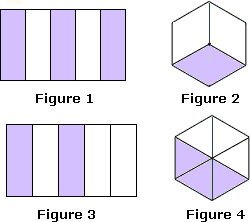Solved Examples and Worksheet for Constructing Models of Equivalent Fractions

A. Figure 1 and Figure 3
B. Figure 2 and Figure 4
C. Figure 1 and Figure 4
D. Figure 1 and Figure 2
Step: 1
Figure 1 represents 2 4
Step: 2
Figure 2 represents 2 4
Step: 3
Figure 3 represents 3 4
Step: 4
Figure 4 represents 1 4
Step: 5
So, Figures 1 and 2 are equivalent fractions.
Correct Answer is : Figure 1 and Figure 2

A. Figure 4
B. Figure 3
C. Figure 2
D. Figure 1
Step: 1
Figure 1 represents the fraction 1 4.
[1 out of 4 parts is shaded]
Step: 2
Figure 2 represents the fraction 3 8.
[3 out of 8 parts are shaded]
Step: 3
Figure 3 represents the fraction 3 5.
[3 out of 5 parts is shaded]
Step: 4
Figure 4 represents the fraction 1 2.
[1 out 2 parts is shaded]
Step: 5
The given fraction 3 6 1 2.
[Divide both the top and the bottom numbers by 3, because they both are multiples of 3.]
Step: 6
So, among the figures shown, only Figure 4 is shaded to show a fraction equivalent to 3 6.
[Because, 3 6 1 2.]
Correct Answer is : Figure 4
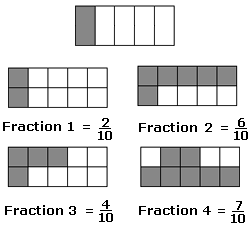
A. Fraction 1
B. Fraction 3
C. Fraction 4
D. Fraction 2
Step: 1
In each of the choices, there are ten equal parts.
Step: 2
Each part represents 1 10.
Step: 3
In Fraction 1, only two parts are shaded. It represents 2 10.
Step: 4
[Because, when we divide the top and the bottom numbers of 2 10 1 5 2 10.]
Step: 5
So, Fraction 1 is equal to 1 5.
Correct Answer is : Fraction 1
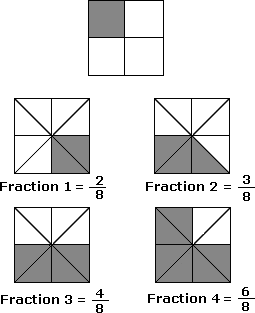
A. Fraction 1
B. Fraction 4
C. Fraction 2
D. Fraction 3
Step: 1
The given figure represents 1 4.
Step: 2
Among the fractions listed, look for the one that reduces to 1 4
Step: 3
Among the fractions listed, only the fraction 2 8 1 4.
[Divide both its top and the bottom numbers by 2.]
Step: 4
So, Fraction 1 represents the equivalent fraction for the figure shown.
Correct Answer is : Fraction 1
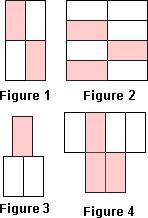
A. Figure 3
B. Figure 4
C. Figure 1
D. Figure 2
Step: 1
Figure 1 shows two out of four parts shaded.
Step: 2
Figure 2 shows three out of eight parts shaded.
Step: 3
Figure 3 shows one out of three parts shaded.
Step: 4
Figure 4 shows three out of six parts shaded.
Step: 5
So, Figure 3 shows a fraction equivalent to 1 3
Correct Answer is : Figure 3
Step: 1
In Figure 1, three out of five equal parts are shaded (3 5
Step: 2
In Figure 2, one out of three equal parts is shaded (1 3
Step: 3
In Figure3, two out of five equal parts is shaded (2 5
Step: 4
In Figure 4, three out of six equal parts are shaded (3 6
Step: 5
So, among the given figures, Figure 2 is 1 3
Correct Answer is : Figure 2
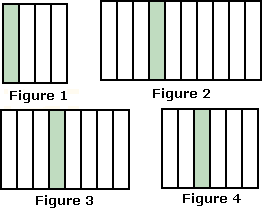
A. Figure 4
B. Figure 1
C. Figure 2
D. Figure 3
Step: 1
In Figure 1, one out of four parts is shaded (1 4
Step: 2
In Figure 2, one out of ten parts is shaded (1 10
Step: 3
In Figure 3, one out of eight parts is shaded (1 8
Step: 4
In Figure 4, one out of six parts is shaded (1 6
Step: 5
So, Figure 3 is 1 8
Correct Answer is : Figure 3
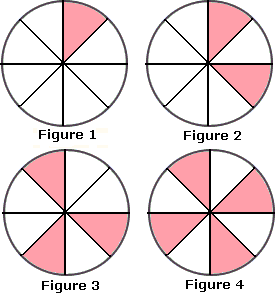
A. Figure 3
B. Figure 2
C. Figure 4
D. Figure 1
Step: 1
In Figure 1, one out of eight parts is shaded (1 8
Step: 2
In Figure 2, two out of eight parts is shaded (2 8
Step: 3
In Figure 3, three out of eight parts is shaded (3 8
Step: 4
In Figure 4, four out of eight parts is shaded (4 8
Step: 5
So, Figure 2 is 2 8
Correct Answer is : Figure 2

A. Figure 1 and Figure 2
B. Figure 1 and Figure 3
C. Figure 2 and Figure 3
Step: 1
Figure 1 represents the fraction 3 4.
[3 out of 4 parts is shaded]
Step: 2
Figure 2 represents the fraction 9 12.
[9 out of 12 parts is shaded]
Step: 3
And 9 12 3 4
[Dividing both numerator and denominator of 9 12
Step: 4
Figure 3 represents the fraction 8 12.
[8 out of 12 parts is shaded.]
Step: 5
So, Figure 1 and Figure 2 have an equivalent fraction shaded.
[From steps 1 and 3.]
Correct Answer is : Figure 1 and Figure 2
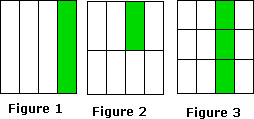
A. all the three
B. Figure 1 and Figure 3
C. Figure 2 and Figure 3
D. Figure 1 and Figure 2
Step: 1
In Figure 1, 1 out of 4 parts are shaded. So, the fraction represented by it is 1 4
Step: 2
In Figure 2, 1 out of 8 parts are shaded. So, the fraction represented by it is 1 8
Step: 3
In Figure 3, 3 out of 12 parts are shaded. So it represents 3 12
Step: 4
An equivalent fraction is a fraction whose numerator and denominator are a multiple of the numerator and denominator of the original fraction.
For example,2 3 4 6 2 3
For example,
Step: 5
So, Figure 1 and Figure 3 represent equivalent fractions.
[Figure 1 represents 1 4 3 12 1 × 3 4 × 3 1 4
Correct Answer is : Figure 1 and Figure 3
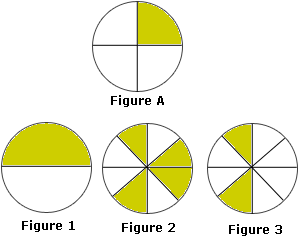
A. Figure 1
B. Figure 3
C. Figure 2
D. All three figures
Step: 1
Figure A represents the fraction 1 4
[1 out of 4 parts is shaded.]
Step: 2
Figure 1 represents the fraction 1 2
[1 out of 2 parts is shaded.]
Step: 3
Figure 2 represents the fraction 4 8
[4 out of 8 parts are shaded.]
Step: 4
Figure 3 represents the fraction 2 8
[2 out of 8 parts are shaded.]
Step: 5
An equivalent fraction is a fraction whose numerator and denominator are a multiple of the numerator and denominator of the original fraction.
For example,2 3 4 6 2 3
For example,
Step: 6
So, Figure 3 shows a fraction equivalent to the fraction represented by Figure A.
[Figure 3 respresents the fraction 2 8 1 × 2 4 × 2 1 4
Correct Answer is : Figure 3
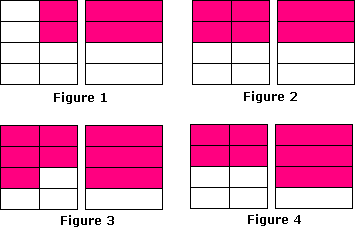
A. Figure 3
B. Figure 4
C. Figure 1
D. Figure 2
Step: 1
The fractions represented by the pair in Figure 1 are 2 8 2 4
Step: 2
The fractions represented by the pair in Figure 2 are 4 8 2 4
Step: 3
The fractions represented by the pair in Figure 3 are 5 8 3 4
Step: 4
The fractions represented by the pair in Figure 4 are 4 8 3 4
Step: 5
An equivalent fraction is a fraction whose numerator and denominator are a multiple of the numerator and denominator of the original fraction.
For example,2 3 4 6 2 3
For example,
Step: 6
So, fractions represented by the pair in Figure 2 are equivalent.
[4 8 2 × 2 4 × 2 2 4
Correct Answer is : Figure 2
- Expressing whole numbers as fractions and vice-versa-Gr 3-Solved Examples
- Fractions as part of a unit Wholes-Gr 3-Solved Examples
- Representing Fractions on a Number Line-Gr 3-Solved Examples
- Comparing Fractions-Like Denominators-Gr 3-Solved Examples
- Equivalent Fractions-Gr 3-Solved Examples
Related Worksheet
- Equivalent Fractions
